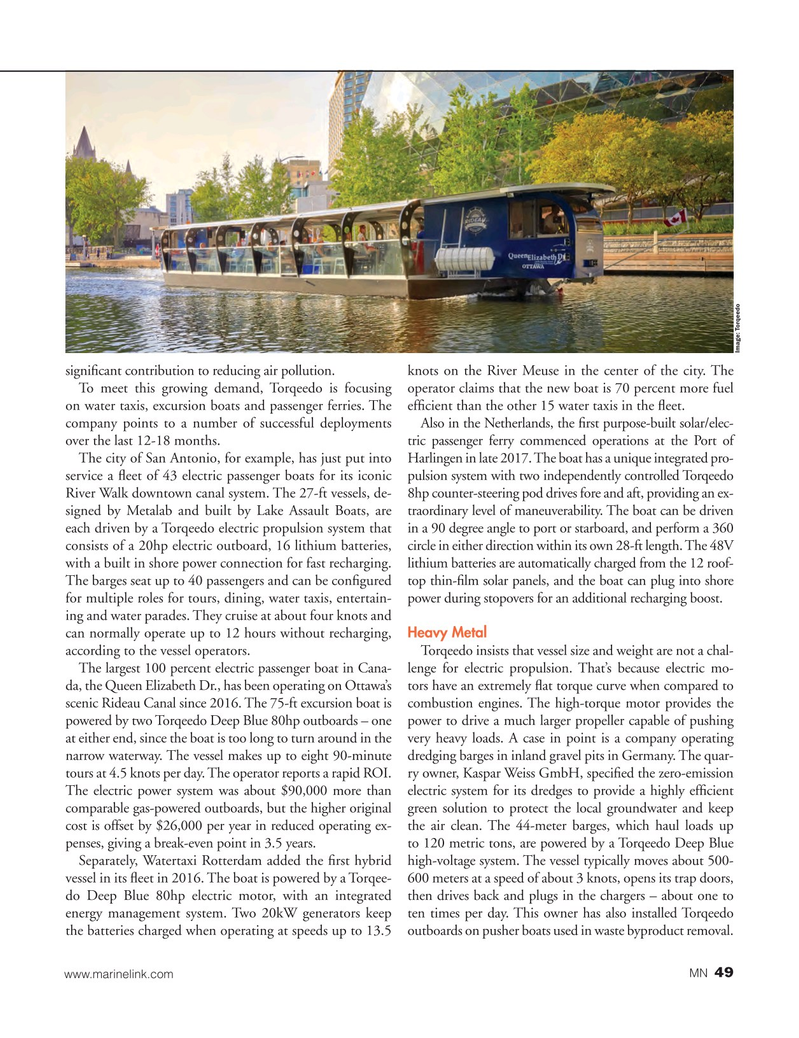
Page 49: of Marine News Magazine (January 2018)
Passenger Vessels & Ferries
Read this page in Pdf, Flash or Html5 edition of January 2018 Marine News Magazine
Image: Torqeedo signi? cant contribution to reducing air pollution. knots on the River Meuse in the center of the city. The
To meet this growing demand, Torqeedo is focusing operator claims that the new boat is 70 percent more fuel on water taxis, excursion boats and passenger ferries. The ef? cient than the other 15 water taxis in the ? eet.
company points to a number of successful deployments Also in the Netherlands, the ? rst purpose-built solar/elec- over the last 12-18 months. tric passenger ferry commenced operations at the Port of
The city of San Antonio, for example, has just put into Harlingen in late 2017. The boat has a unique integrated pro- service a ? eet of 43 electric passenger boats for its iconic pulsion system with two independently controlled Torqeedo
River Walk downtown canal system. The 27-ft vessels, de- 8hp counter-steering pod drives fore and aft, providing an ex- signed by Metalab and built by Lake Assault Boats, are traordinary level of maneuverability. The boat can be driven each driven by a Torqeedo electric propulsion system that in a 90 degree angle to port or starboard, and perform a 360 consists of a 20hp electric outboard, 16 lithium batteries, circle in either direction within its own 28-ft length. The 48V with a built in shore power connection for fast recharging. lithium batteries are automatically charged from the 12 roof-
The barges seat up to 40 passengers and can be con? gured top thin-? lm solar panels, and the boat can plug into shore for multiple roles for tours, dining, water taxis, entertain- power during stopovers for an additional recharging boost.
ing and water parades. They cruise at about four knots and can normally operate up to 12 hours without recharging, Heavy Metal according to the vessel operators. Torqeedo insists that vessel size and weight are not a chal-
The largest 100 percent electric passenger boat in Cana- lenge for electric propulsion. That’s because electric mo- da, the Queen Elizabeth Dr., has been operating on Ottawa’s tors have an extremely ? at torque curve when compared to scenic Rideau Canal since 2016. The 75-ft excursion boat is combustion engines. The high-torque motor provides the powered by two Torqeedo Deep Blue 80hp outboards – one power to drive a much larger propeller capable of pushing at either end, since the boat is too long to turn around in the very heavy loads. A case in point is a company operating narrow waterway. The vessel makes up to eight 90-minute dredging barges in inland gravel pits in Germany. The quar- tours at 4.5 knots per day. The operator reports a rapid ROI. ry owner, Kaspar Weiss GmbH, speci? ed the zero-emission
The electric power system was about $90,000 more than electric system for its dredges to provide a highly ef? cient comparable gas-powered outboards, but the higher original green solution to protect the local groundwater and keep cost is offset by $26,000 per year in reduced operating ex- the air clean. The 44-meter barges, which haul loads up penses, giving a break-even point in 3.5 years. to 120 metric tons, are powered by a Torqeedo Deep Blue
Separately, Watertaxi Rotterdam added the ? rst hybrid high-voltage system. The vessel typically moves about 500- vessel in its ? eet in 2016. The boat is powered by a Torqee- 600 meters at a speed of about 3 knots, opens its trap doors, do Deep Blue 80hp electric motor, with an integrated then drives back and plugs in the chargers – about one to energy management system. Two 20kW generators keep ten times per day. This owner has also installed Torqeedo the batteries charged when operating at speeds up to 13.5 outboards on pusher boats used in waste byproduct removal.
49 www.marinelink.com MN

 48
48

 50
50
